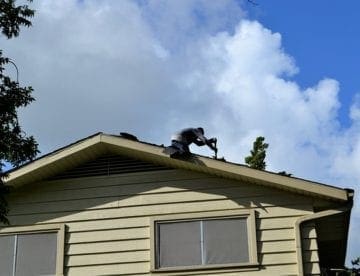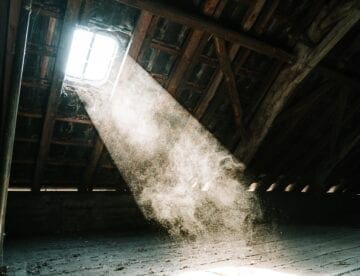Tampa Bay, Florida, is no stranger to the destructive force of damaging storms and hurricanes. Homeowners in the area realize that having a safe, secure roof is key to protecting the home and everyone inside. A crucial aspect of a hurricane-resistant roof is the thickness of the decking material. A damaged roof can lead to leaks and mold, affecting the building’s integrity. Additionally, high winds can send roof material flying away, potentially harming neighbors or passersby.
This article explores the optimal thickness of roof decking. You’ll also learn how to choose the correct roofing material to ensure your home’s roof can withstand fierce winds accompanying the next hurricane or tropical storm in Tampa Bay, FL.
Understanding Roof Decking and Its Importance in Hurricane Resistance
Roof decking is the layer of material installed onto the roof framing. It provides a sturdy base for the roof shingles and tiles. Its primary function is to distribute the weight of the asphalt shingle, concrete tile, or metal panels evenly across the entire roof. It also serves as a barrier to protect the interior of the building from outside elements, including water, wind, and debris.
Thicker roof decking contributes to wind resistance as it provides enhanced structural strength and stability to the roof. The additional hurricane-resistant roof decking thickness helps in several additional ways. Here are a few:
- It helps withstand high wind loads and severe weather conditions caused by hurricanes.
- Reduces the risk of damage caused by wind uplift, shingle blow-off, and leaks due to wind-driven rain.
- Provides increased resistance to the impact of hail or falling debris.
- It helps preserve the roof’s integrity, reducing the need for repairs.
Factors Influencing Roof Decking Thickness in Hurricane Zones
The Tampa Bay area has significant climatic challenges, all impacting roofing systems. Central western Florida experiences a subtropical climate, with hot and humid summers, mild winters, and high rainfall throughout the year. These weather conditions pose several challenges for roofs in the area.
According to research, Tampa has an “extreme wind factor” risk. Researchers say that, compared to 30 years ago, wind speeds in Tampa are higher, putting 100 percent of homes at risk of storm damage. Additionally, high wind speeds and heavy rain increase the risk of flooding.
Building codes also impact the choice and cost of roof decking in Tampa. For example, Florida Building Code 706.1 states that the entire roofing section must be replaced if the roof is damaged by more than 25 percent and was not properly permitted after March 1, 2009. Building codes also affect pitch requirements.
Recommended Thickness for Hurricane Resistant Roof Decking in Tamp
Florida’s building codes set deck requirements to make roofs hurricane-proof. The minimum thickness requirement for oriented strand board (OSB) roof decking is 7/16 inches for wind speeds up to 140 mph. However, depending on your location and roof pitch, the minimum requirement is 19/32 inches.
Here are the best practices for installing roof decking in hurricane-prone areas:
- Choose a thicker roof sheathing.
- Use compatible roofing materials for the roof pitch and location.
- Properly secure the structural panels to the roof framing.
- Use a waterproofing membrane or underlayment.
- Strengthen roof sheathing with the recommended size of shank cap nails.
- Conduct regular roof inspections and maintain the roof to address any potential repair issues or damage promptly.
It’s always best to hire a trusted roofing company that understands local building codes and regulations in Tampa Bay.
Implementation: Choosing and Installing the Right Roof Decking
Hiring the right roofing experts is key to ensuring your roof stays in place during the next tropical storm or hurricane. Here are some tips on finding suitable roofing experts in Tampa Bay, FL:
- Research: Look for contractors with proven experience and expertise in installing hurricane-proof roofs.
- Credentials: Check the contractor’s credentials and licenses. For example, they should belong to the National Roofing Contractors Association (NRCA) and have a Florida High Wind certification (TRI). Also, check their BBB rating.
- References: Ask for references from past clients, referrals from friends, and check online reviews.
- Quotes: Get quotes from several contractors to compare their pricing, materials, and labor costs.
- Warranties: Check information on the warranties provided by the contractor and the manufacturer of the roof decking materials.
What are some things to look for to ensure the contractor installs roof decking suitable for homes in Tampa Bay? Here are a few factors to consider:
- Use quality, corrosion-resistant fasteners appropriate to the type of roof deck and framing.
- Ensure the design has enough roof vents to provide proper ventilation and prevent moisture buildup in the roof space.
- Consider installing a cool roof to reduce energy use and improve weather resistance.
- Ensure all flashing is installed correctly.
Beyond Thickness: Other Considerations for Hurricane-Proof Roofing
In addition to choosing the right type of roof decking, several other roof-covering materials can improve resilience during severe weather events. Here are a few:
- Roof underlayment: The right type of underlayment helps provide a waterproof membrane to protect against wind-driven rain.
- Roof trusses and rafters: Reinforced connections and proper bracing are essential to ensure the stability and integrity of the roof system during a hurricane.
- Flashing: Robust flashing seals help protect vulnerable areas of the roof, such as roof edges, chimneys, and vents. Additionally, drip edges and fascia should be properly anchored and securely fastened to prevent wind uplift and damage.
- Roof slope and shape: The best roof pitch for hurricane-prone areas is 30 degrees. A steep slope helps resist powerful uplifts caused by high winds.
- Installation methods: Consider weather-resistant additions like hurricane straps and protective roof coatings. Also, ensure the roofing contractor only uses high-quality fasteners, sealants, and adhesives to protect the roof against storm damage.
Incorporating additional roofing elements and following best practices for installation enhances your roof’s hurricane resistance.
Final Thoughts: Ensuring Optimal Roof Decking Thickness for Maximum Hurricane Resistance in Tampa
Choosing the right type of roof decking is critical for maximizing hurricane resistance for your home in Tampa. The roofing system must conform to Florida’s requirements for roof decking regarding minimum thickness requirements. Hiring a trusted roofing contractor with experience and expertise in roof construction and design in hurricane-prone areas is crucial.
Do you need to hurricane-proof your roof or arrange for roof repairs after a severe weather event in Tampa? If so, contact Code Engineered Systems today. Our team of experienced roofers has experience in all types of roof decking and installing roofing systems.Don’t wait until it’s too late—contact us now and protect your home against the next hurricane. Call us at 813-373-9088 or visit our website to get a free quote.




